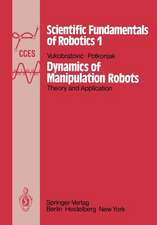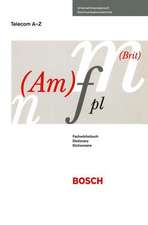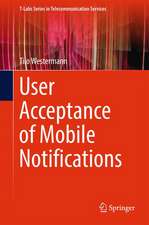Content-Centric Networks: An Overview, Applications and Research Challenges: SpringerBriefs in Electrical and Computer Engineering
Autor Syed Hassan Ahmed, Safdar Hussain Bouk, Dongkyun Kimen Limba Engleză Paperback – 10 mar 2016
It begins with an introduction to the basics of CCN is followed by an overview of the current internet paradigm and its challenges. Next, an application perspective has been included, where the authors encompass the selected applications for CCN with recent refereed research and developments. These applications include Internet of Things (IoT), Smart Grid, Vehicular Ad hoc Networks (VANETs), and Wireless Sensor Networks (WSNs).
The book is a useful reference source for practising researchers, and can be used as supporting material for undergraduate and graduate level courses in computer science and electrical engineering.
Din seria SpringerBriefs in Electrical and Computer Engineering
- 19%
 Preț: 424.47 lei
Preț: 424.47 lei -
 Preț: 377.35 lei
Preț: 377.35 lei -
 Preț: 380.07 lei
Preț: 380.07 lei -
 Preț: 378.12 lei
Preț: 378.12 lei - 20%
 Preț: 379.08 lei
Preț: 379.08 lei -
 Preț: 377.18 lei
Preț: 377.18 lei - 20%
 Preț: 234.68 lei
Preț: 234.68 lei - 20%
 Preț: 232.43 lei
Preț: 232.43 lei -
 Preț: 378.12 lei
Preț: 378.12 lei -
 Preț: 377.18 lei
Preț: 377.18 lei - 20%
 Preț: 231.41 lei
Preț: 231.41 lei -
 Preț: 377.18 lei
Preț: 377.18 lei -
 Preț: 377.95 lei
Preț: 377.95 lei -
 Preț: 444.74 lei
Preț: 444.74 lei -
 Preț: 382.36 lei
Preț: 382.36 lei -
 Preț: 378.12 lei
Preț: 378.12 lei -
 Preț: 378.92 lei
Preț: 378.92 lei - 20%
 Preț: 232.43 lei
Preț: 232.43 lei -
 Preț: 376.80 lei
Preț: 376.80 lei -
 Preț: 377.35 lei
Preț: 377.35 lei -
 Preț: 377.18 lei
Preț: 377.18 lei -
 Preț: 381.00 lei
Preț: 381.00 lei -
 Preț: 376.43 lei
Preț: 376.43 lei -
 Preț: 377.18 lei
Preț: 377.18 lei -
 Preț: 378.54 lei
Preț: 378.54 lei - 20%
 Preț: 321.20 lei
Preț: 321.20 lei -
 Preț: 377.73 lei
Preț: 377.73 lei -
 Preț: 341.75 lei
Preț: 341.75 lei -
 Preț: 344.25 lei
Preț: 344.25 lei -
 Preț: 379.09 lei
Preț: 379.09 lei - 20%
 Preț: 324.64 lei
Preț: 324.64 lei -
 Preț: 377.57 lei
Preț: 377.57 lei -
 Preț: 378.71 lei
Preț: 378.71 lei - 20%
 Preț: 321.66 lei
Preț: 321.66 lei - 20%
 Preț: 230.85 lei
Preț: 230.85 lei -
 Preț: 374.30 lei
Preț: 374.30 lei -
 Preț: 375.45 lei
Preț: 375.45 lei -
 Preț: 360.05 lei
Preț: 360.05 lei -
 Preț: 381.43 lei
Preț: 381.43 lei -
 Preț: 378.34 lei
Preț: 378.34 lei -
 Preț: 376.22 lei
Preț: 376.22 lei - 20%
 Preț: 323.99 lei
Preț: 323.99 lei -
 Preț: 380.07 lei
Preț: 380.07 lei -
 Preț: 375.62 lei
Preț: 375.62 lei - 20%
 Preț: 321.20 lei
Preț: 321.20 lei -
 Preț: 377.18 lei
Preț: 377.18 lei - 5%
 Preț: 361.80 lei
Preț: 361.80 lei -
 Preț: 378.12 lei
Preț: 378.12 lei -
 Preț: 375.07 lei
Preț: 375.07 lei -
 Preț: 376.22 lei
Preț: 376.22 lei
Preț: 377.35 lei
Nou
Puncte Express: 566
Preț estimativ în valută:
72.22€ • 75.12$ • 59.62£
72.22€ • 75.12$ • 59.62£
Carte tipărită la comandă
Livrare economică 14-28 aprilie
Preluare comenzi: 021 569.72.76
Specificații
ISBN-13: 9789811000645
ISBN-10: 9811000646
Pagini: 90
Ilustrații: XVI, 90 p. 32 illus., 13 illus. in color.
Dimensiuni: 155 x 235 x 6 mm
Greutate: 0.16 kg
Ediția:1st ed. 2016
Editura: Springer Nature Singapore
Colecția Springer
Seria SpringerBriefs in Electrical and Computer Engineering
Locul publicării:Singapore, Singapore
ISBN-10: 9811000646
Pagini: 90
Ilustrații: XVI, 90 p. 32 illus., 13 illus. in color.
Dimensiuni: 155 x 235 x 6 mm
Greutate: 0.16 kg
Ediția:1st ed. 2016
Editura: Springer Nature Singapore
Colecția Springer
Seria SpringerBriefs in Electrical and Computer Engineering
Locul publicării:Singapore, Singapore
Cuprins
Preface.- Acknowledgment.- 1 Introduction.- 2 Information Centric Network (ICN).- 3 Content Centric Network (CCN).- 4 Future Aspects.- References.- Glossary.
Notă biografică
Syed HassanAhmed received his B.S in Computer Science from Kohat University of Science andTechnology (KUST), Kohat, Pakistan. Later on, he joined School of ComputerScience and Engineering, Kyungpook National University, Korea, where hecompleted his Masters in Computer Engineering. Currently, he is pursuing hisPhD in Computer Engineering at Monet Lab, KNU, Korea. In 2015, he has been avisiting researcher at the Georgia Institute of Technology, Atlanta, USA. Since2012, he has published over 50 International Journal and Conference papers inthe multiple topics of wireless communications. Along with several bookchapters, he also authored 2 Springer brief books. He is also an activeIEEE/ACM member and serving several reputed conferences/journals as a TPC andReviewer respectively. For the three consecutive years, 2014-2016, he won theBest Research Contributor awards in the workshop on Future Researches ofComputer Science and Engineering, KNU, South Korea. His research interestsinclude WSN, Underwater WSN, Cyber Physical Systems, VANETs and InformationCentric Networks in Vehicular Communications.
Safdar Hussain Bouk was born in Larkana, Pakistan in 1977. He received the B.S. degree in Computer Systems from Mehran University of Engineering and Technology, Jamshoro, Pakistan, in 2001 and M.S. and Ph.D. in Engineering from the Department of Information and Computer Science, Keio University, Yokohama, Japan in 2007 and 2010, respectively. Currently he is a working as a Postdoctoral Fellowship at Kyungpook National University, Daegu, Korea. His research interests include wireless ad-hoc, sensor networks, underwater sensor networks, and information centric networks.
DongkyunKim received the BS degree from the Department of ComputerEngineering, Kyungpook National University, Daegu, Korea. He also receivedthe MS and PhD degrees from the School of Computer Science and Engineering,Seoul National University, Seoul, Korea. Hewas a visiting researcher at theGeorgia Institute of Technology, Atlanta, in 1999. He also performed apostdoctorate program in the Computer Engineering Department, University ofCalifornia at Santa Cruz, in 2002. He has been organizing committeeor technical program committee in many IEEE or ACM conferences. He received theBest Paper Award from the Korean Federation of Science and TechnologySocieties, 2002. He has been doing many editorial activities in severalwell-reputed international journals. Currently, he is a professor in the Schoolof Computer Science and Engineering, Kyungpook National University, Daegu, Korea.His current research interest includes connected cars, vehicular ad hocnetworks, Internet of Things (M2M/D2D), Wi-Fi networks (including Wi-FiDirect), wireless mesh networks, wireless sensor networks, and Future Internet.He is a member of the IEEE.
Safdar Hussain Bouk was born in Larkana, Pakistan in 1977. He received the B.S. degree in Computer Systems from Mehran University of Engineering and Technology, Jamshoro, Pakistan, in 2001 and M.S. and Ph.D. in Engineering from the Department of Information and Computer Science, Keio University, Yokohama, Japan in 2007 and 2010, respectively. Currently he is a working as a Postdoctoral Fellowship at Kyungpook National University, Daegu, Korea. His research interests include wireless ad-hoc, sensor networks, underwater sensor networks, and information centric networks.
DongkyunKim received the BS degree from the Department of ComputerEngineering, Kyungpook National University, Daegu, Korea. He also receivedthe MS and PhD degrees from the School of Computer Science and Engineering,Seoul National University, Seoul, Korea. Hewas a visiting researcher at theGeorgia Institute of Technology, Atlanta, in 1999. He also performed apostdoctorate program in the Computer Engineering Department, University ofCalifornia at Santa Cruz, in 2002. He has been organizing committeeor technical program committee in many IEEE or ACM conferences. He received theBest Paper Award from the Korean Federation of Science and TechnologySocieties, 2002. He has been doing many editorial activities in severalwell-reputed international journals. Currently, he is a professor in the Schoolof Computer Science and Engineering, Kyungpook National University, Daegu, Korea.His current research interest includes connected cars, vehicular ad hocnetworks, Internet of Things (M2M/D2D), Wi-Fi networks (including Wi-FiDirect), wireless mesh networks, wireless sensor networks, and Future Internet.He is a member of the IEEE.
Textul de pe ultima copertă
This book introduces Content-Centric Networking (CCN), a networking paradigm that provides a simple and effective solution to the challenging demands of future wired and wireless communications. It provides an overview of the recent developments in the area of future internet technologies, bringing together the advancements that have been made in Information-Centric Networking (ICN) in general, with a focus on CCN.
It begins with an introduction to the basics of CCN is followed by an overview of the current internet paradigm and its challenges. Next, an application perspective has been included, where the authors encompass the selected applications for CCN with recent refereed research and developments. These applications include Internet of Things (IoT), Smart Grid, Vehicular Ad hoc Networks (VANETs), and Wireless Sensor Networks (WSNs).
The book is a useful reference source for practising researchers, and can be used as supporting material for undergraduate and graduate level courses in computer science and electrical engineering.
It begins with an introduction to the basics of CCN is followed by an overview of the current internet paradigm and its challenges. Next, an application perspective has been included, where the authors encompass the selected applications for CCN with recent refereed research and developments. These applications include Internet of Things (IoT), Smart Grid, Vehicular Ad hoc Networks (VANETs), and Wireless Sensor Networks (WSNs).
The book is a useful reference source for practising researchers, and can be used as supporting material for undergraduate and graduate level courses in computer science and electrical engineering.
Caracteristici
Describes the emergence of Content-Centric Networking with various technologies including the Internet of Things, Smart Grids, Wireless Sensor Networks and Vehicular Ad-hoc Networks Includes application-oriented chapters and recently-published research Provides a source of information and an overview of future communications trends for both students and researchers of computer science and electrical engineering Includes supplementary material: sn.pub/extras



























